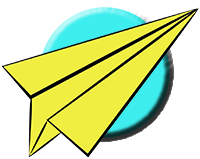Minnow Paper Plane Instructions
Minnow Paper Plane Instructions
Instructions
1. Make a crease to fold the paper in half. The crease line should go from the upper right corner of the paper to the lower left corner. This can be a bit tricky so take your time.
2. Rotate the paper around so the crease created previously is on the left hand side.
3. Fold the paper exactly in half, bringing the top point down to meet the bottom point. Unfold after the crease has been made.
4. Fold the left edge of the paper over. The width of the fold should be about one finger width. Be sure the crease is parallel to the left edge of the paper all the way from end to end.
5. Fold the left edge of the paper over again on top of itself. Be sure the new crease is parallel to the left edge of the paper. Make the crease as tight as possible.
6. Fold the upper right point down so the right half of the top diagonal edge lines up with the center line crease. The left point of the new crease should be at the middle of the top diagonal edge where the existing center line crease hits the edge.
7. Repeat on the left side. Fold the upper left point down so the top edge lines up with the center line crease. The right point of the new crease should be at the top edge where the existing center line crease hits the edge.
8. Make a crease to fold the right top-most flap over. The upper left point of the crease should be about two finger widths down from the tip of the nose and the new crease should be parallel with the right diagonal edge.
9. Repeat on the left side. Make a crease to fold the left top-most flap over. The upper right point of the crease should be about two finger widths dwon from the tip of the nose and the new crease should be parallel with the right diagonal edge. Be sure to line up the left and right sides for good balance.
10. Fold the tip of the nose down so the top point hits the center line crease. Make the new crease as close to the wing flaps as possible.
11. Flip the plane over and rotate it around so the nose points to the right.
12. Fold the plane exactly in half about the existing center line crease. Be sure to line up the sides for good balance. The paper in the nose section is so thick now that it may split apart a bit. This is normal.
13. Rotate the plane around so the nose is on the left and the wing flaps are up.
14. Make a crease for the first wing flap. The right point of the new crease should be at the right-most point of the fuselage and the left point should be about one finger width up from the bottom edge.
15. Flip the plane over and rotate it around so the first wing flap is underneath and the nose points to the right.
16. Make a crease for the second wing flap. Be sure to line up the wing flaps for good balance and flying characteristics.
17. Flip the plane over and rotate it around so the wing flaps are up and the nose points to the right.
18. Make a crease for the first winglet. The right point of the new crease should be at the upper right point of the top-most flap and the left point should be where the second layer of paper joins the first layer along the back edge.
19. Flip the plane over and rotate it around so the first winglet is underneath and the nose points to the left.
20. Make a crease for the second winglet. The left point of the new crease should be at the upper left point of the top-most flap and the right point should be where the second layer of paper joins the first layer along the back edge.
21. Open up the main wing flaps and the winglets and adjust them so they are even. Be sure to balance the left and right sides for good flying characteristics. Set the dihedral angle slightly upward and curl the wingtips up slightly. Set the winglets as vertical as possible.
THE THROW Launch with moderate to hard throw at a slight up angle. A piece of tape to hold the side together to maintain an up dihedral is useful. If it rolls to the right or left, adjust the opposite wing tip to compensate. This plane can be thrown hard when properly trimmed.
